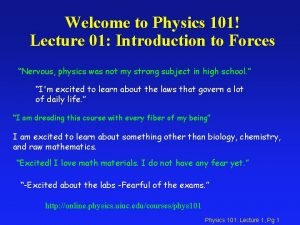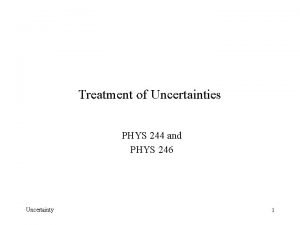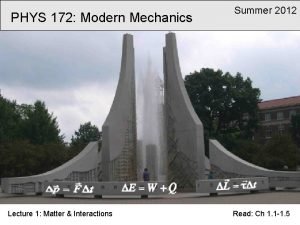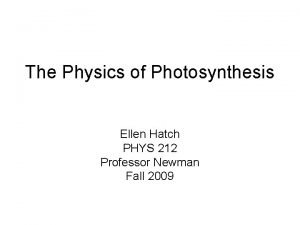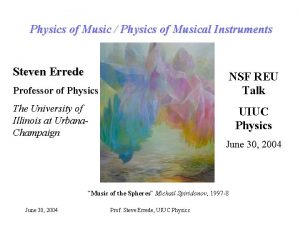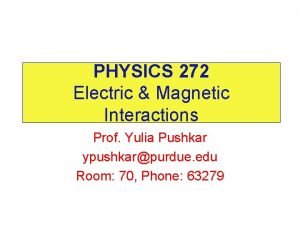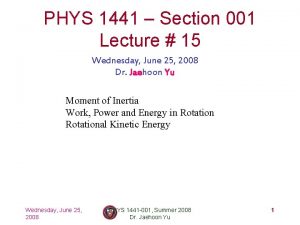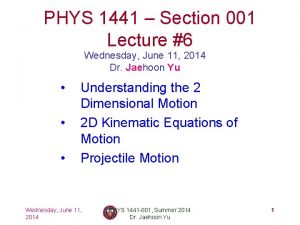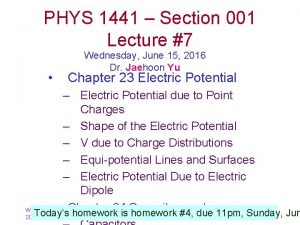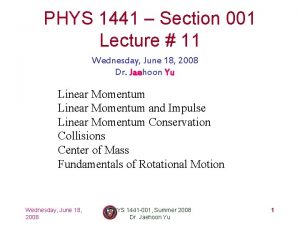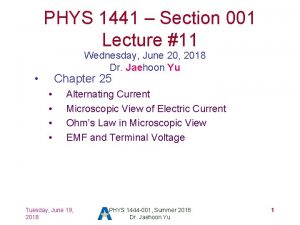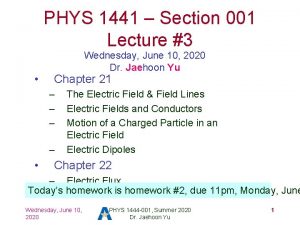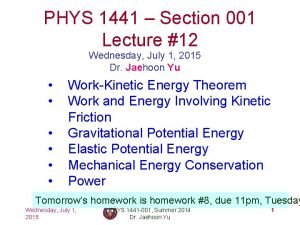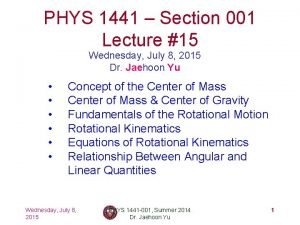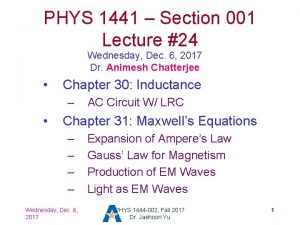PHYS 1441 Section 001 Lecture 3 Wednesday June













- Slides: 13

PHYS 1441 – Section 001 Lecture #3 Wednesday, June 8, 2016 Dr. Jaehoon Yu • Chapter 21 – – Coulomb’s Law The Electric Field & Field Lines Electric Fields and Conductors Motion of a Charged Particle in an Electric Field – Electric Dipoles Today’s homework is homework #2, due 11 pm, Saturday, June 11!! Wednesday, June 8, 2016 PHYS 1444 -001, Summer 2016 Dr. Jaehoon Yu 1

Announcements • 34/35 of you have registered in the homework system. – 27/35 submitted the homework! • 1 st non-comprehensive term exam – In class Monday, June 13 – Covers: CH 21. 1 through what we finish tomorrow plus appendix A – Bring your calculator but DO NOT input formula into it! • Cell phones or any types of computers cannot replace a calculator! – BYOF: You may bring a one 8. 5 x 11. 5 sheet (front and back) of handwritten formulae and values of constants for the quiz – No derivations, word definitions or solutions of any Wednesday, June 8, PHYS 1444 -001, Summer 2016 2 problems! 2016 Dr. Jaehoon Yu

Extra Credit Special Project #1 • Compare the Coulomb force to the Gravitational force in the following cases by expressing Coulomb force (FC) in terms of the gravitational force (FG) – Between two protons separated by 1 m – Between two protons separated by an arbitrary distance R – Between two electrons separated by 1 m – Between two electrons separated by an arbitrary distance R • Five points each, totaling 20 points • BE SURE to show all the details of your work, including all formulae, and properly references Wednesday, June 8, PHYS 1444 -001, Summer 2016 3 2016 Dr. Jaehoon Yu to them

Coulomb’s Law – The Formula • Is Coulomb force a scalar quantity or a vector quantity? Unit? – A vector quantity. The unit is Newtons (N)! • The direction of electric (Coulomb) force is always along the line joining the two objects. – If the two charges are the same: forces are directed away from each other. – If the two charges are opposite: forces are directed toward each other. • • • The valueforce of theisproportionality Coulomb precise to 1 part in 1016. constant, k, in SI unit is Coulomb, C, in SI. Unit of charge is called Thus, 1 C is the charge that gives 9 N 8, Wednesday, June PHYS 1444 -001, Summer 2016 F~9 x 10 of force when placed 1 m 2016 Dr. Jaehoon Yu 4

• The Elementary Charge and Permittivity Elementary charge, the smallest charge, is that of an electron: – Since electron is a negatively charged particle, its charge is –e. • Object cannot gain or lose fraction of an electron. – Electric charge is quantized. • It changes always in integer multiples of e. • The proportionality constant k is often written in terms of another constant, ε 0, the permittivity* of free space. They are related and. • Thus the electric force can be written: *Mirriam-Webster, Permittivity: The ability of a material to store electric potential energy under the influenc June 8, this force PHYS 1444 -001, Summer 2016 charges at rest. 5 • Wednesday, Note that is for “point” 2016 Dr. Jaehoon Yu

Example on Coulomb Force • Electric force on electron by proton. Determine the magnitude of the electric force on the electron of a hydrogen atom exerted by the single proton (Q 2=+e) that is its nucleus. Assume the electron “orbits” the proton at its average distance of r=0. 53 x 10 -10 m. Using Coulomb’s law Each charge is and So the magnitude of the force is Which direction? Toward each other… Wednesday, June 8, 2016 PHYS 1444 -001, Summer 2016 Dr. Jaehoon Yu 6

Example 21 – 1 • Which charge exerts greater force? Two positive point charges, Q 1=50μC and Q 2=1μC, are separated by a distance L. Which is larger in magnitude, the force that Q 1 exerts on Q 2 or the force that Q 2 exerts on Q 1? What is the force that Q 1 exerts on Q 2? What is the force that Q 2 exerts on Q 1? Therefore the magnitudes of the two forces are identical!! Well then what is different? The direction. Which direction? Opposite to each other! What is this law? Newton’s third law, the law of action and reaction!! Wednesday, June 8, 2016 PHYS 1444 -001, Summer 2016 Dr. Jaehoon Yu 7

• Vector Additions and Subtractions Addition: – Triangular Method: One can add vectors by connecting the head of one vector to the tail of the other (head-to-tail) – Parallelogram method: Connect the tails of the two vectors and extend – Addition is commutative: Changing order of operation does not affect the results A+B=B+A, A+B=B+A A+B+C+D+E=E+C+A+B+D A A+B B A = B A A+B OR B A+B A • Subtraction: – The same as adding a negative vector: A - B = A + (-B) A A-B -B Since subtraction is the equivalent to adding a negative vector, subtraction is also commutative!!! • Multiplication by a scalar is increasing the magnitude A, B=2 A June 8, Wednesday, 2016 A PHYS 1444 -001, Summer 2016 Dr. Jaehoon Yu B=2 A 8

Example for Vector Addition A force of 20. 0 N applies to north while another force of 35. 0 N applies in the direction 60. 0 o west of north. Find the magnitude and direction of resultant force. F 2 sin 60 o N F 260 o F cos 60 o 2 F θ 20 F 1 E Wednesday, June 8, 2016 PHYS 1444 -001, Summer 2016 Dr. Jaehoon Yu Find other ways to solve this problem… 9

Components and Unit Vectors Coordinate systems are useful in expressing vectors in their components y (+, +) Fy (Fx, Fy) F Components (-, +) } θ (-, -) Wednesday, June 8, 2016 (+, -) Fx x PHYS 1444 -001, Summer 2016 Dr. Jaehoon Yu } Magnitud 10

Unit Vectors • Unit vectors are the ones that tells us the directions of the components • Dimensionless • Magnitudes are exactly 1 • Unit vectors are usually expressed in i, j, k or So the vector F can be re-written as Wednesday, June 8, 2016 PHYS 1444 -001, Summer 2016 Dr. Jaehoon Yu 11

Examples of Vector Operations. F 1 i+2. 0 j)N and F 2 Find the resultant force which is the sum of F 1=(2. 0 i-4. 0 j)N. Find the resultant force of the sum of three forces: F 1=(15 i+30 j +12 k)N, F 2=(23 i+14 j -5. 0 k)N, and F 3=(13 i+15 j)N. Magnitu de Wednesday, June 8, 2016 PHYS 1444 -001, Summer 2016 Dr. Jaehoon Yu 12

Example 21. 2 • Three charges in a line. Three charged particles are arranged in a line as shown in the figure. Calculate the net electrostatic force on particle 3 (the -4μC on. What theisright) duethat to other twooncharges. the force Q 1 exerts Q 3? What is the force that Q 2 exerts on Q 3? Using the vector sum of the two forces Wednesday, June 8, 2016 PHYS 1444 -001, Summer 2016 Dr. Jaehoon Yu 13
 Jan van eyck (1390-1441)
Jan van eyck (1390-1441) Purdue physics 241
Purdue physics 241 01:640:244 lecture notes - lecture 15: plat, idah, farad
01:640:244 lecture notes - lecture 15: plat, idah, farad Physics 102 uiuc
Physics 102 uiuc Phys 101 uiuc
Phys 101 uiuc Phys courses ucsd
Phys courses ucsd Percent difference formula
Percent difference formula Phys 172
Phys 172 Single slit envelope
Single slit envelope Http //www.phys.hawaii.edu/ teb/optics/java/slitdiffr/
Http //www.phys.hawaii.edu/ teb/optics/java/slitdiffr/ Phys 212 equation sheet
Phys 212 equation sheet Phys 398 uiuc
Phys 398 uiuc Coloumb units
Coloumb units In the term antipyretic the root pyret means
In the term antipyretic the root pyret means




